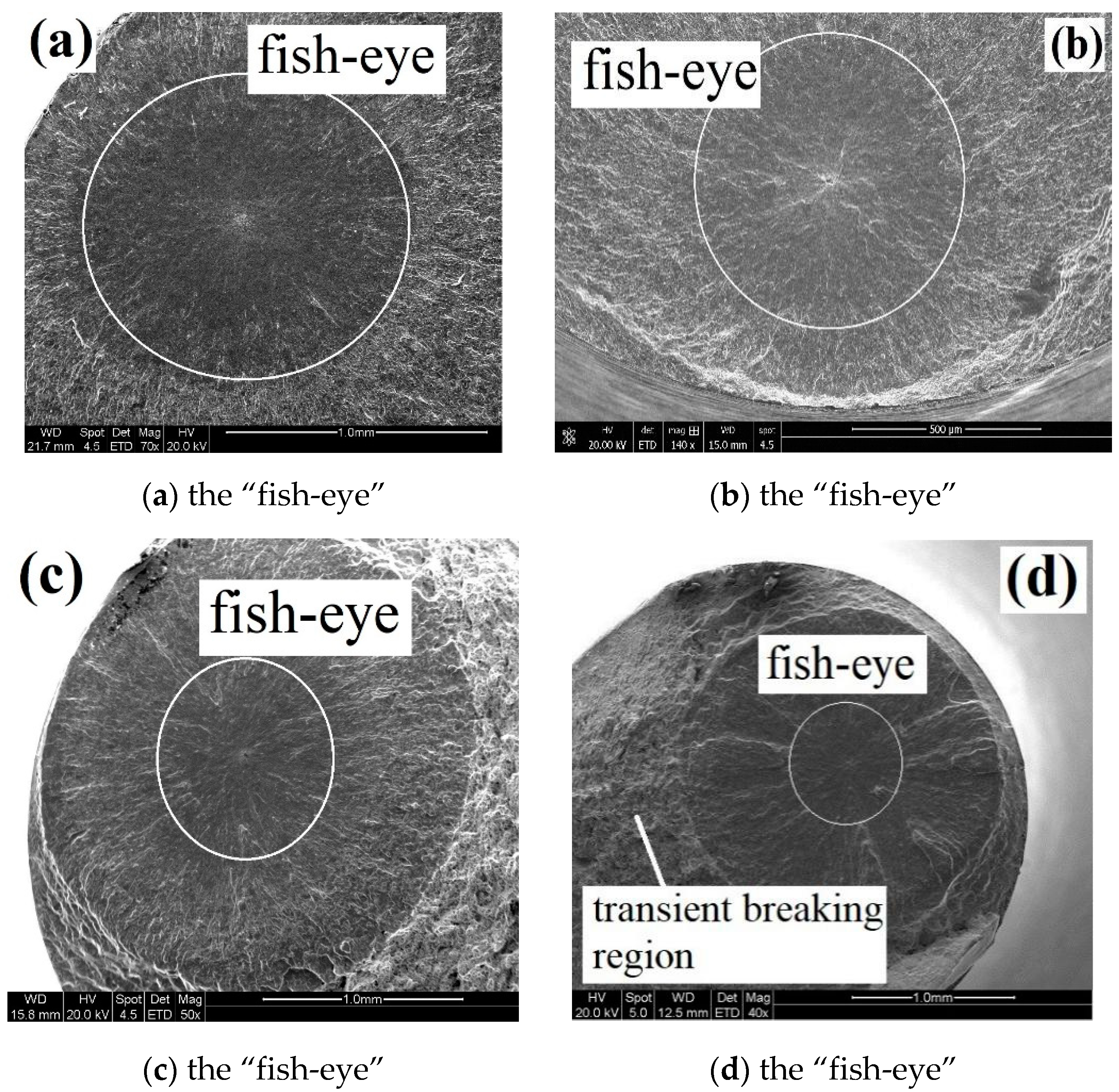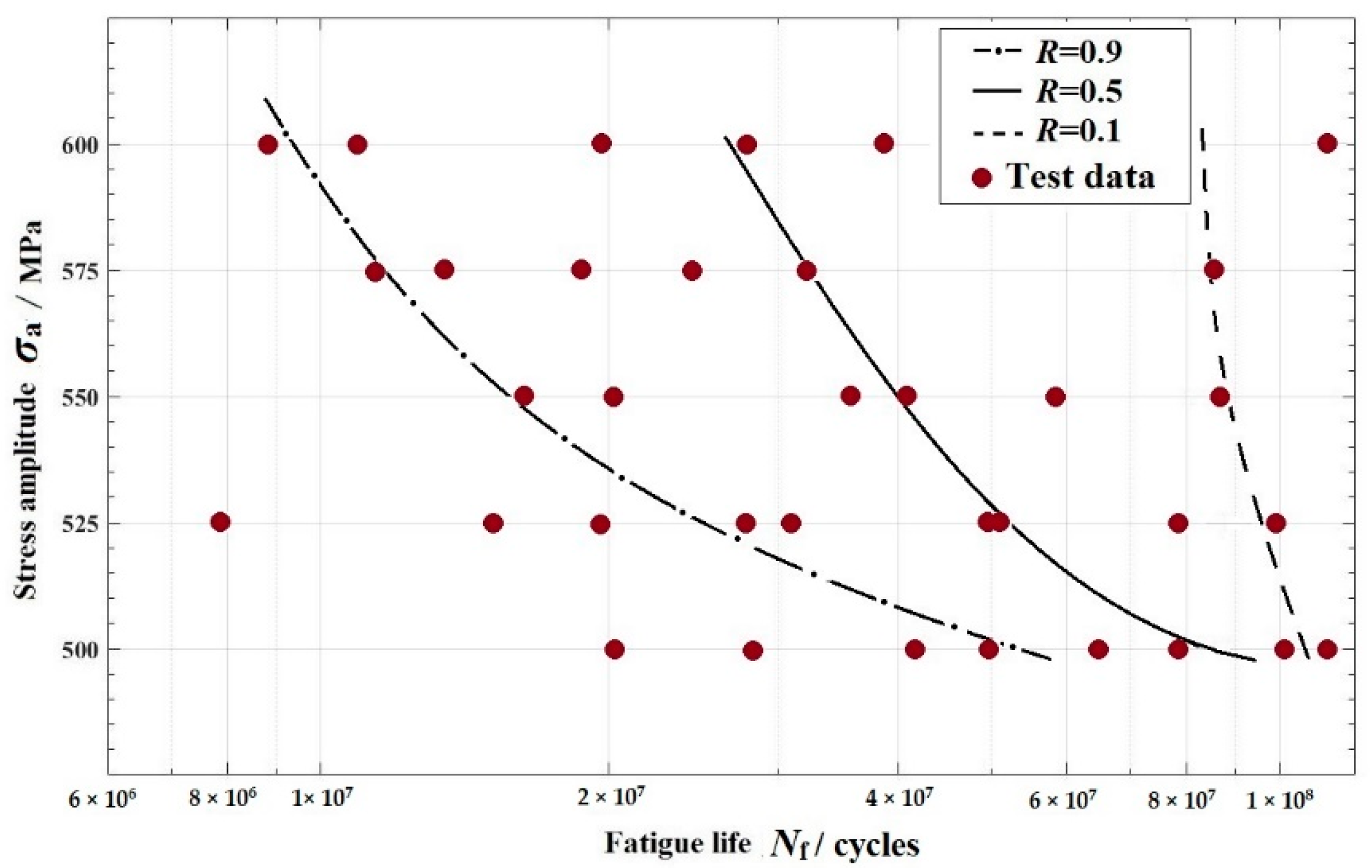Fatigue Life Evaluation Considering Fatigue Reliability and Fatigue Crack for FV520B-I in VHCF Regime Based on Fracture Mechanics
Abstract
:1. Introduction
2. Materials and Methods Fatigue Test
2.1. Test Method
2.2. Material and Specimen
2.3. The Results and Observations
3. Fatigue Reliability of FV520B-I in the VHCF Regime
3.1. Very-High Cycle Fatigue Life Distribution of FV520B-I in the VHCF Regime
3.2. The P-S-N Curve Estimation
3.3. Discussion
4. The Fatigue Life Evaluation for FV520B-I
4.1. The Fatigue Life Evaluation Model Considering Reliability
4.2. Further Assumption: The P-Sc-N Curve
4.3. Discussions
5. Conclusions
- (1)
- The ultrasonic fatigue test for FV520B-I was performed. Obvious evidence of very-high cycle fatigue failure in FV520B-I, including “fish-eye” and GBF regions, were detected on the fracture surface; these are constant with the reported results of the very-high cycle fatigue study.
- (2)
- A three-parameter model for FV520B-I was achieved. The unknown parameters related to FV520B-I were obtained, and the fatigue reliability of FV520B-I in the VHCF regime was modeled. The corresponding P-S-N curves with different fatigue reliability values were drawn, respectively. The determination of the three-parameter model and the P-S-N curve for FV520B-I make up for the lack of a fatigue reliability study of FV520B-I in the VHCF regime.
- (3)
- A new fatigue evaluation model for FV520B-I, considering fatigue reliability and fatigue crack, was developed based on the P-S-N curves. This new model was verified using the test data and the errors were in an acceptable range.
- (4)
- A new relationship curve between fatigue reliability, fatigue crack and fatigue life N for FV520B-I in the VHCF regime was proposed: the P-Sc-N curve. The P-Sc-N curve model with different reliability values was developed with the combined application of the classic formula and test data. The corresponding P-S-N curves with different fatigue reliability values were drawn, respectively.
- (5)
- Using the P-Sc-N curve for FV520B-I, it was observed that there is a negative correlation between fatigue cracking and the reliability for FV520B-I. The new P-Sc-N curve is also useful for the decision-making process in re-manufacturing, based on the fatigue cracking information.
Author Contributions
Funding
Acknowledgments
Conflicts of Interest
References
- Wang, J.L.; Zhang, Y.L.; Zhao, Q.C.; Zhang, H.C. Study of fatigue crack critical threshold of remanufacturing cores and judgment of re-manufacturability based on fatigue crack. Chin. J. Mech. Eng. CHS 2017, 53, 41–49. [Google Scholar] [CrossRef]
- Zhang, M.; Wang, W.Q.; Wang, P.F.; Liu, Y.; Li, J.F. Fatigue behavior and mechanism of FV520B-I welding seams in a very high cycle regime. Int. J. Fatigue. 2016, 87, 22–37. [Google Scholar] [CrossRef]
- Fujii, T.; Maekawa, Z. Fatigue Life Analysis of Particle Dispersed Composite Materials by Reliability Concept. J. Soc. Mater. Sci. Jpn. 1978, 27, 984–990. [Google Scholar] [CrossRef]
- Weibull, W. Fatigue Testing and Analysis of Results; Pergamon Press: London, UK, 1961. [Google Scholar]
- Weibull, W. A Statistical function of the wide applicability. J. Appl. Mech. 1951, 18, 293–300. [Google Scholar]
- Smaga, M.; Boemke, A.; Daniel, T.; Skorupski, R.; Sorich, A.; Beck, T. Fatigue behavior of metastable austenitic stainless steels in LCF, HCF and VHCF regimes at ambient and elevated temperatures. Metals 2019, 9, 704. [Google Scholar] [CrossRef] [Green Version]
- Rozumek, D.; Marciniak, Z.; Lesiuk, G.; Correia, J.A.; de Jesus, A.M. Experimental and numerical investigation of mixed mode I+ II and I+ III fatigue crack growth in S355J0 steel. Int. J. Fatigue 2018, 113, 160–170. [Google Scholar] [CrossRef]
- Hong, Y.S.; Liu, X.L.; Lei, Z.Q.; Sun, C.Q. The formation mechanism of characteristic region at crack initiation for very-high-cycle fatigue of high-strength steels. Int. J. Fatigue 2016, 89, 108–118. [Google Scholar] [CrossRef] [Green Version]
- Wirsching, P.H.; Wu, Y.T. Probabilistic and Statistical Methods of Fatigue Analysis and Design. Press. Vessel Pip. Technol. A Decade Prog. 1985, 793–819. [Google Scholar]
- Wu, Y.T.; Wirsching, P.H. Advanced Reliability Method for Fatigue Analysis. J. Eng. Mech. 1984, 110, 536–553. [Google Scholar] [CrossRef]
- Martin, W.S.; Wirsching, P.H. Fatigue crack initiation-propagation reliability model. J. Mater. Civil. Eng. 1991, 3, 1–18. [Google Scholar] [CrossRef]
- Martindale, S.G.; Wirsching, P.H. Reliability-based Progressive Fatigue Collapse. J. Struct. Eng. 1983, 109, 1792–1811. [Google Scholar] [CrossRef]
- Wang, H.; Guo, L.Z.; Lin, H.Q.; Yang, Y.L. Research on Life of Sliding Rail and Idler Wheel and Reliability Under Constant Amplitude Load. Bearing 2016, 10, 36–39. [Google Scholar]
- Wang, W.S.; Zhao, L.; Huang, Y.; Zhu, H.C.; Su, Y.N. The bending fatigue strength test based on the reliability of material 8822H. Locomot. Roll. Stock Technol. 2015, 3, 35–37. [Google Scholar]
- Wurzel, G.; Alderliesten, R. Reliability modeling for rotorcraft component fatigue life prediction with assumed usage. Aeronaut. J. 2016, 1, 1–35. [Google Scholar]
- Paolino, D.S.; Tridello, A.; Chiandussi, G.; Rossetto, M. Effect of crack size on P-S-N curves in Very-High-Cycle Fatigue. Procedia Struct. Integr. 2017, 7, 335–342. [Google Scholar] [CrossRef]
- Liu, S.J.; Liu, C.; Hu, Y.W.; Gao, S.B.; Wang, Y.F.; Zhang, H.C. Fatigue life assessment of centrifugal compressor impeller based on FEA. Eng. Fail. Anal. 2016, 60, 383–390. [Google Scholar] [CrossRef]
- Liu, C.; Liu, S.J.; Gao, S.B.; Hu, Y.W.; Zhang, S.X.; Zhang, H.C. Fatigue life assessment of the centrifugal compressor impeller with cracks based on the properties of FV520B. Eng. Fail. Anal. 2016, 66, 177–186. [Google Scholar] [CrossRef]
- Wang, J.L.; Zhang, Y.L.; Zhao, Q.C.; Zhang, M.; Guan, Z.M.; Lu, H.T. The fatigue failure analysis and fatigue life prediction model of FV520B-I as a function of surface roughness in HCF regime. J. Mater. Res. 2017, 32, 634–643. [Google Scholar] [CrossRef]
- Zhang, Y.L.; Wang, J.L.; Sun, Q.C.; Zhang, H.; Jiang, P.S. Fatigue Life Prediction of FV520B with Internal Inclusions. Mater. Des. 2015, 69, 241–246. [Google Scholar] [CrossRef]
- Wang, J.L.; Zhang, Y.L.; Sun, Q.C.; Liu, S.J.; Shi, B.W.; Lu, H.T. Giga-fatigue life prediction of FV520B-I with surface roughness. Mater. Des. 2016, 89, 1028–1034. [Google Scholar] [CrossRef]
- Wang, J.L.; Zhang, Y.L.; Shi, B.W.; Zhao, Q.C.; Sun, Q.C.; Zhang, Z.; Lu, H.Y. Fatigue behavior and mechanism of FV520B-I owing to the effect of loading frequency on the fatigue property in HCF and VHCF regime. Arch. Metall. Mater. 2018, 63, 347–357. [Google Scholar]
- Shiozawa, K.; Lu, L.; Ishihara, S. S-N curve characteristics and subsurface crack initiation behaviour in ultra-long life fatigue of a high carbon-chromium bearing steel. Fatigue Fract. Eng. Mater. 2010, 24, 781–790. [Google Scholar] [CrossRef]
- Shiozawa, K.; Lu, L. Very high-cycle fatigue behaviour of shot-peened high-carbon-chromium bearing steel. Fatigue Fract. Eng. Mater. 2010, 25, 813–822. [Google Scholar] [CrossRef]
- Shiozawa, K.; Morii, Y.; Nishino, S.; Lu, L. Subsurface crack initiation and propagation mechanism in high-strength steel in a very high cycle fatigue regime. Int. J. Fatigue 2006, 28, 1521–1532. [Google Scholar] [CrossRef]
- Murakami, Y. Mechanism of fatigue failure in ultralong life regime and application to fatigue design. Fatigue Fract. Eng. Mater. 2002, 15, 2927–2938. [Google Scholar]
- Murakami, Y.; Takada, M.; Toriyama, T. Super-longlife tension-compression fatigue properties of quenehed a tempered 0.46% Carbon steel. Int. J. Fatigue 1998, 16, 661–667. [Google Scholar] [CrossRef]
- Murakami, Y. Metal Fatigue-Effects of Small Cracks and Nonmetallic Inclusions; Elsevier: Amsterdam, The Netherlands; Boston, MA, USA, 2002; Volume 6–7, pp. 314–316. [Google Scholar]
- Chen, J.Q. Models for fatigue life distribution. J. Mech. Strength 1991, 13, 42–45. [Google Scholar]
- Fu, H.M.; Gao, Z.T. A method for fitting P-S-N curve. Acta Aeronaut. ET Astronaut. Sin. 1988, 9, 338–341. [Google Scholar]
- Basquin, O.H. The Exponential Law of Endurance Tests. Am. Soc. Test. Mater. Proc. 1910, 10, 625–630. [Google Scholar]
- Ling, J.; Pan, J. A maximum likelihood method for estimating P-S-N curves. Int. J. Fatigue 1997, 19, 415–419. [Google Scholar] [CrossRef]
- Zhao, Y.X.; Wang, J.N.; Gao, Q. A unified classical maximum likelihood approach for estimating P-S-N curves of three commonly used fatigue stress-life relations. Chin. J. Appl. Mech. 2001, 18, 83–90. [Google Scholar]
- Sun, Z.D.; Li, W.; Zhang, Z.Y.; Deng, H.L.; Zhang, X.H. A method to building probabilistic S-N curves for multiple failure modes in very high cycle fatigue. Eng. Mech. 2016, 33, 218–224. [Google Scholar]












| Chemical Composition | C | Si | Ni | Cu | S | Cr | Mo | Nb | Fe |
|---|---|---|---|---|---|---|---|---|---|
| Content | 0.02–0.07 | 0.15–0.7 | 5–6 | 1.3–1.8 | <0.025 | 13–14.5 | 1.3–1.8 | 0.25–0.45 | Bal |
| Mechanical Parameters | Elastic Modulus E (GP) | Tensile Strength Rm (MPa) | Yield Strength Rp0.2 (MPa) | Vickers Hardness HV | Elongation A (%) |
|---|---|---|---|---|---|
| FV520B-I | 194 | 1180 | 1029 | 380 | 16.07 |
| Stress Amplitude | 500 MPa | 525 MPa | 600 MPa |
|---|---|---|---|
| location parameter μ | 2.1673 | 1.6429 | 1.0239 |
| proportional parameter σ | 0.4372 | 0.4213 | 0.8989 |
| Stress Amplitude σa/MPa | S1 | S2 | S3 |
|---|---|---|---|
| The fatigue reliability R | 0.5 | 0.5 | 0.5 |
| Fatigue life Nf | 2.78 × 107 | 5.17 × 107 | 8.73 × 107 |
| S0,0.5 | α0.5 | C0.5 |
|---|---|---|
| 481.1823 | 0.6205 | 53.9676 |
| Stress Amplitude σa/MPa | 600 | 525 | 500 |
|---|---|---|---|
| Fatigue reliability R | 0.5 | 0.5 | 0.5 |
| Fatigue life Nf | 2.78 × 107 | 5.17 × 107 | 8.73 × 107 |
| Fatigue crack Sc/μm | 322 | 139.4 | 90.6 |
© 2020 by the authors. Licensee MDPI, Basel, Switzerland. This article is an open access article distributed under the terms and conditions of the Creative Commons Attribution (CC BY) license (http://creativecommons.org/licenses/by/4.0/).
Share and Cite
Wang, J.; Yang, Y.; Yu, J.; Wang, J.; Du, F.; Zhang, Y. Fatigue Life Evaluation Considering Fatigue Reliability and Fatigue Crack for FV520B-I in VHCF Regime Based on Fracture Mechanics. Metals 2020, 10, 371. https://doi.org/10.3390/met10030371
Wang J, Yang Y, Yu J, Wang J, Du F, Zhang Y. Fatigue Life Evaluation Considering Fatigue Reliability and Fatigue Crack for FV520B-I in VHCF Regime Based on Fracture Mechanics. Metals. 2020; 10(3):371. https://doi.org/10.3390/met10030371
Chicago/Turabian StyleWang, Jinlong, Yuxing Yang, Jing Yu, Jingsi Wang, Fengming Du, and Yuanliang Zhang. 2020. "Fatigue Life Evaluation Considering Fatigue Reliability and Fatigue Crack for FV520B-I in VHCF Regime Based on Fracture Mechanics" Metals 10, no. 3: 371. https://doi.org/10.3390/met10030371
APA StyleWang, J., Yang, Y., Yu, J., Wang, J., Du, F., & Zhang, Y. (2020). Fatigue Life Evaluation Considering Fatigue Reliability and Fatigue Crack for FV520B-I in VHCF Regime Based on Fracture Mechanics. Metals, 10(3), 371. https://doi.org/10.3390/met10030371





